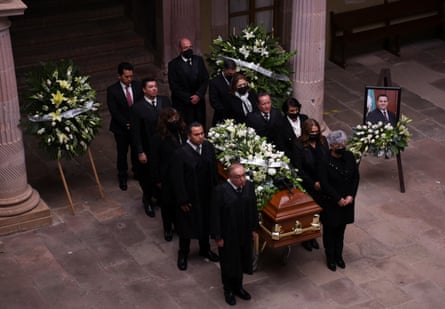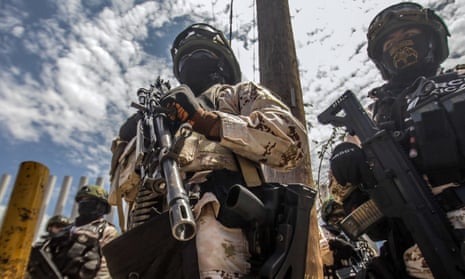The news came almost as fast as the bullets were fired: a judge murdered in cold blood; cartel members attempting a prison break; five people killed at a bar in a popular port city.
The surge in violence over a single weekend in Mexico brought a torrent of headlines that are increasingly familiar as powerful gangs battle for control of the country: shootouts, cars set on fire, bodies lying in the street.
It has become a steady drumbeat of conflict that underscores the ongoing failure of President Andrés Manuel López Obrador’s security strategy – and the inability of his government to tackle the scourge.
“There’s this false sense that we are moving away from a latent state of armed, violent, lethal conflict,” said Falko Ernst, a Mexico security analyst at the International Crisis Group. “But we must be conscious that we’re talking about a staggering level of homicides and other lethal practices that are still the norm in Mexico.”

Despite campaigning on a promise to take the military off the streets, López Obrador, or Amlo as he’s commonly known, has increasingly relied on the armed forces to tackle the violence, deploying the army and the national guard across the country.
On Monday the Mexican president addressed the weekend’s wave of attacks in Zacatecas state, where, a day after a judge was shot dead, cars were set on fire and roads blocked off as inmates at a prison tried to escape.
“This weekend, there were these very unfortunate events: the loss of life, the murder of a judge,” the president said during his morning news conference, before blaming the violence on the inaction of previous governments. “We are improving, we are advancing, we will not stop protecting the people.”
But the very next day, the carnage continued.
On Tuesday a shooting near a kindergarten in Sinaloa state left two dead; a video shared on social media showed children cowering under their desks as their teacher tried to comfort them with the music of Taylor Swift.
On Wednesday morning another shootout between the military and members of an organized crime gang in the border city of Nuevo Laredo left seven people dead, just over a week after shootouts forced schools in the city to cancel classes.
Preliminary figures from the Mexican government show that there have been an average of 78 murders a day this month in Mexico – about three killings an hour.
Amlo has pointed to a slight drop in murders since he took office as sign his strategy is working. Overall homicides dropped by about 7% in the first 10 months of 2022, compared with the same period last year, official figures show.
But given that more than 26,000 Mexicans have been murdered this year, such a dip is hardly a victory, analysts say.

“We’re still going to come out north of 30,000 homicides that have been officially counted by any standard this year,” said Ernst. “We’re still talking about this staggeringly high level. I think that selling that as a success is politically convenient, but it has its own perverted logic.”
Zacatecas state has become a focal point for the violence as powerful organized crime groups compete for the strategically significant region, with highways that head both toward the northern border and the Pacific coast.
Between 2015 and 2021, the number of murders in the state increased by a staggering 400%. In January this year, an SUV with 10 dead bodies was dumped in front of the offices of the state governor, David Monreal Ávila, in the state capital, also called Zacatecas.
“The issue of violence is terrifying,” said Victor Piña, a lifelong resident of Zacatecas state who lives in the city of Fresnillo. “The situation is out of control.”
On Sunday, as reports emerged of violence erupting in the city after the failed prison break, Piña sheltered at home with his son, listening to the sirens that have become a common soundtrack in this city.
The next day, driving out of town, Piña saw the aftermath: burned carcasses of trucks set on fire as roadblocks, which, according to the state security secretary, Adolfo Marín Marín, had been set up to draw attention away from the attempted prison break.
“It terrifies me,” Piña said of the violence. “It fills me with rage, with indignation.”
Quick GuideMexico's evolving war on drugs
Show
Calderón sends in the army
Mexico’s “war on drugs” began in late 2006 when the president at the time, Felipe Calderón, ordered thousands of troops on to the streets in response to an explosion of horrific violence in his native state of Michoacán.
Calderón hoped to smash the drug cartels with his heavily militarized onslaught but the approach was counterproductive and exacted a catastrophic human toll. As Mexico’s military went on the offensive, the body count skyrocketed to new heights and tens of thousands were forced from their homes, disappeared or killed.
Kingpin strategy
Simultaneously, Calderón also began pursuing the so-called “kingpin strategy” by which authorities sought to decapitate the cartels by targeting their leaders.
That policy resulted in some high-profile successes – notably Arturo Beltrán Leyva, who was gunned down by Mexican marines in 2009 – but also did little to bring peace. In fact, many believe such tactics served only to pulverize the world of organized crime, creating even more violence as new, less predictable factions squabbled for their piece of the pie.
Under Calderón’s successor, Enrique Peña Nieto, the government’s rhetoric on crime softened as Mexico sought to shed its reputation as the headquarters of some the world’s most murderous mafia groups.
But Calderón’s policies largely survived, with authorities targeting prominent cartel leaders such as Sinaloa’s Joaquín “El Chapo” Guzmán.
When “El Chapo” was arrested in early 2016, Mexico’s president bragged: “Mission accomplished”. But the violence went on. By the time Peña Nieto left office in 2018, Mexico had suffered another record year of murders, with nearly 36,000 people slain.
'Hugs not bullets'
The leftwing populist Andrés Manuel López Obrador took power in December, promising a dramatic change in tactics. López Obrador, or Amlo, as most call him, vowed to attack the social roots of crime, offering vocational training to more than 2.3 million disadvantaged young people at risk of being ensnared by the cartels.
“It will be virtually impossible to achieve peace without justice and [social] welfare,” Amlo said, promising to slash the murder rate from an average of 89 killings per day with his “hugs not bullets” doctrine.
Amlo also pledged to chair daily 6am security meetings and create a 60,000 strong national guard. But those measures have yet to pay off, with the new security force used mostly to hunt Central American migrants.
Mexico now suffers an average of about 96 murders a day.
Zacatecas has become a focus for Amlo’s chief security strategy, with the government announcing last November that it would be sending about 4,000 members of the military and national guard to tackle organized crime in the state.
But more than a year later, with violence again overwhelming the state, the limits of the president’s strategy has been laid bare, according to analysts.
“It’s another example of the failed policy of military deployment,” said Catalina Pérez Correa, a law professor at Mexico City’s CIDE university. “There are areas of the country that are simply out of state control.”
And as the strategy of militarization fails, residents like Piña are left to deal with unending violence.
“I love my home profoundly,” he said. “And I see that it’s going through the worst crisis in its history.”
